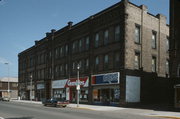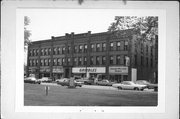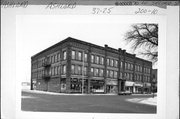Property Record
200-10 W 2ND ST
Architecture and History Inventory
| Historic Name: | WILMARTH BLOCK #1/PARMETER BLDG |
|---|---|
| Other Name: | (VARIOUS SMALL BUSINESSES) |
| Contributing: | Yes |
| Reference Number: | 870 |
| Location (Address): | 200-10 W 2ND ST |
|---|---|
| County: | Ashland |
| City: | Ashland |
| Township/Village: | |
| Unincorporated Community: | |
| Town: | |
| Range: | |
| Direction: | |
| Section: | |
| Quarter Section: | |
| Quarter/Quarter Section: |
| Year Built: | 1886 |
|---|---|
| Additions: | |
| Survey Date: | 1983 |
| Historic Use: | retail building |
| Architectural Style: | Commercial Vernacular |
| Structural System: | |
| Wall Material: | Cream Brick |
| Architect: | LEWIS C WILMARTH (A) |
| Other Buildings On Site: | |
| Demolished?: | No |
| Demolished Date: |
| National/State Register Listing Name: | West Second Street Historic District |
|---|---|
| National Register Listing Date: | 2/2/1984 |
| State Register Listing Date: | 1/1/1989 |
| National Register Multiple Property Name: |
| Additional Information: | MASSIVE COMMERCIAL BLOCK WITH BROWNSTONE PIERS. BRICK CORBEL TABLE. RICHLY DECORATED OAK HALLWAY INTACT. ONE OF FIVE BLDGS BY WILMARTH. ONE OF TWO WILMARTH BLDGS INDISTRICT. [Date Cnst:CA] Lewis C. Wilmarth was born in Foster, Rhode Island in 1833 and died in 1907 in Ashland. Wilmarth helped to layout the City of Topeka, Kansas. He was mayor of Ashland from 1890-91, and was a reputable businessman who designed his own business blocks. This is the best surviving example of five. Wilmarth was also commemorated by naming of Wilmarth School, now on NRHP, see ISF 32-10, 32-13. Description: This massive cream brick and brownstone six-part facade features a central projecting rusticated entry way that supports two similarly treated piers. Four additional piers divide the facade symmetrically. The rectangular windows, three per bay, are united horizontally by the continuous brownstone lintel and sill courses, endig at brownstone quoins. One of five similarly styled commercial blocks desinged in Ashland by Wilmarth, the building's projecting cornice, central parapet wall, and reticulated brick frieze are common Wilmarth building features. The interior of the second and third floor features apartments that are accessible by central halls richly decorated with unaltered classically-detailed oak wainscoting, panelled doors and an elaborate stairway with newel posts, bannisters and balustrades all of which were custom manufactured by Scott Hubbell and Taylor Company. The first floor storefronts on the 2nd Avenue West and West Second Street facades have been only superficially altered with the iron beams and brownstone piers intact. Significance: This pivotal structure is the largest building in the district and is architecturally significant as a well-preserved example of a local interpretation of the early Commercial style by Lewis C. Wilmarth of Ashland who designed and had built a total of four similarly styled commercial blocks. A second example, Wilmarth Building No. 5 (#54) is part of the district and with this property provides a stylistic link along West Second Street. This large apartment building is important for its use of native brownstone and cream brick in Wilmarth's individual Commercial style which is more polychromatic than its Chicago counterpart. More important for the district's unity, the Wilmarth blocks were designed in an early Commercial style character that employs these local materials in a decorative manner that is far more sympathetic to Ashland's architectural tradition than to any imported more strictly followed Commercial Style. Lastly, the well-preserved interior is significant as a beautiful example of Neo-Classical Revival style interior woodwork executed by the Scott-Taylor Company of Ashland. |
|---|---|
| Bibliographic References: | [A] ASHLAND SALUTES 100 YEARS OF PROGRESS. |
| Wisconsin Architecture and History Inventory, State Historic Preservation Office, Wisconsin Historical Society, Madison, Wisconsin |



